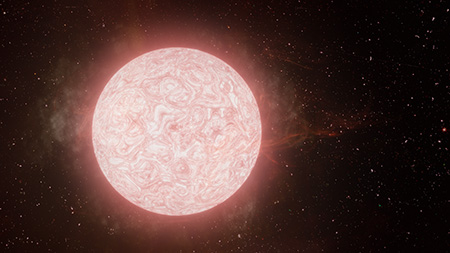Campus News
Astronomers witness the explosive end of a dying star
The Young Supernova Experiment transient survey observed a red supergiant during its final 130 days leading up to a supernova explosion.

For the first time, astronomers have imaged in real time the dramatic end to a red supergiant’s life, watching the massive star’s rapid self-destruction and final death throes before it collapsed into a Type II supernova.
“We finally detected the death throes of this relatively common type of stellar explosion,” said Ryan Foley, assistant professor of astronomy and astrophysics at UC Santa Cruz.
Foley’s team leads the Young Supernova Experiment (YSE) transient survey, which observed the red supergiant during the last 130 days leading up to its deadly detonation. “This was only possible because of the Young Supernova Experiment, which is able to detect subtle changes of very faint and distant stars,” he said.
The research team reported their findings in a paper published January 6 in the Astrophysical Journal.
“This is a breakthrough in our understanding of what massive stars do moments before they die,” said lead author Wynn Jacobson-Galán, a UCSC alumnus and NSF Graduate Research Fellow at UC Berkeley. “Direct detection of pre-supernova activity in a red supergiant star has never been observed before in an ordinary Type II supernova. For the first time, we watched a red supergiant star explode!”
Using the Pan-STARRS telescope at the Haleakala Observatory in Hawaii, the YSE team first detected the doomed massive star in summer of 2020 via the huge amount of light radiating from the red supergiant. A few months later, in fall 2020, a supernova lit the sky.
The team quickly captured the powerful flash and obtained the very first spectrum of the energetic explosion, named supernova 2020tlf, or SN 2020tlf, using the W. M. Keck Observatory’s Low Resolution Imaging Spectrometer (LRIS). The data showed direct evidence of dense circumstellar material surrounding the star at the time of explosion, likely the same gas that Pan-STARRS had imaged the red supergiant star violently ejecting earlier in the summer.
“When the data came off the telescope, I saw the telltale signs of a supernova ramming into some material thrown off the star shortly before explosion,” Foley said.
“Keck was instrumental in providing direct evidence of a massive star transitioning into a supernova explosion,” added senior author Raffaella Margutti, associate professor of astronomy at UC Berkeley. “It’s like watching a ticking time bomb. We’ve never confirmed such violent activity in a dying red supergiant star, where we see it produce such a luminous emission, then collapse and combust, until now.”
The team continued to monitor SN 2020tlf after the explosion. Based on data obtained from Keck Observatory’s DEep Imaging and Multi-Object Spectrograph (DEIMOS) and Near Infrared Echellette Spectrograph (NIRES), they determined SN 2020tlf’s progenitor red supergiant star, located in the NGC 5731 galaxy about 120 million light-years away, was 10 times more massive than the sun.
The discovery defies previous ideas of how red supergiant stars evolve right before blowing up. Prior to this, all red supergiants observed before exploding were relatively quiescent—they showed no evidence of violent eruptions or luminous emission, as was observed prior to SN 2020tlf. However, this novel detection of bright radiation coming from a red supergiant in the final year before exploding suggests that at least some of these stars must undergo significant changes in their internal structure, which then results in the tumultuous ejection of gas moments before they collapse.
Margutti and Jacobson-Galán conducted most of the study during their time at Northwestern University, with Margutti serving as an associate professor of physics and astronomy and member of CIERA (Center for Interdisciplinary Exploration and Research in Astrophysics), and Jacobson-Galán as a graduate student.
The team’s discovery paves a path forward for transient surveys like YSE to hunt for luminous radiation coming from red supergiants and gather more evidence that such behavior could signal the imminent, supernova demise of a massive star.
“I am most excited by all of the new ‘unknowns’ that have been unlocked by this discovery,” said Jacobson-Galán. “Detecting more events like SN 2020tlf will dramatically impact how we define the final months of stellar evolution, uniting observers and theorists in the quest to solve the mystery on how massive stars spend the final moments of their lives.”